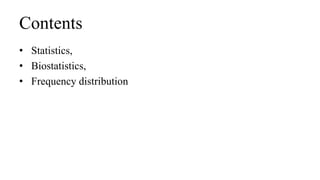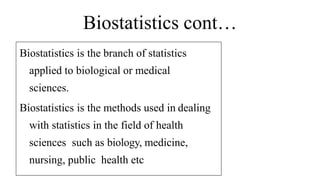Biostatistics Lecture 1 8th Sem B.Pharm AKTU
Download as PPTX, PDF2 likes1,854 views
Biostatistics Unit 1 Lecture 1 AKTU, B.Pharm 8th Semester by Dr. Manoj Kumar Sharma (ITS College of Pharmacy)
1 of 21
Downloaded 10 times





















Recommended
Information on Pharmacovigilance.pptx



Information on Pharmacovigilance.pptxImmanuel Jebastine M
╠²
This document provides information on establishing pharmacovigilance programs and resources in pharmacovigilance. It discusses the importance of classification systems like ATC, ICD, and INN for monitoring drugs and adverse events. Primary resources include clinical trial data and reports, while secondary resources summarize primary sources. Tertiary sources compile information from multiple sources. Establishing an effective pharmacovigilance program requires a structured organization, trained staff, coordination between stakeholders, and support from regulatory authorities and healthcare priorities. Monitoring drug safety is crucial for public health.basic information resource.pptx



basic information resource.pptxSiddharthShekharSing4
╠²
This document discusses information resources in pharmacovigilance. It defines pharmacovigilance as relating to detecting, assessing, understanding, and preventing adverse drug reactions. It outlines the objectives to understand drug information sources and select appropriate ones. It describes primary, secondary, and tertiary resources, providing examples and advantages and disadvantages of each. It also discusses establishing pharmacovigilance programs and centers, including basic steps, operational requirements, and planning considerations.Biostat 8th semester B.Pharm-Introduction Ravinandan A P.pdf



Biostat 8th semester B.Pharm-Introduction Ravinandan A P.pdfRavinandan A P
╠²
This document discusses biostatistics and its applications. It begins by providing examples of class averages, disease rates, medication adherence rates, and comparing drug efficacies that demonstrate the need for biostatistics. It then defines biostatistics as the application of statistical methods to biological and medical data. The document outlines the history of biostatistics and discusses its uses in areas like public health, clinical trials, and medicine. It also covers descriptive and inferential statistics, limitations of statistics, and emphasizes that biostatistics provides an important tool for evidence-based decision making in fields involving human health and biology.II SOCIAL AND HEALTH EDUCATION.pptx



II SOCIAL AND HEALTH EDUCATION.pptxDR.PRISCILLA MARY J
╠²
UNIT II
SOCIAL AND HEALTH EDUCATION.
DR.PRISCILLA MARY J
ASSISTANT PROFESSOR,
DEPARTMENT OF PHARMACY PRACTICE.Unit 2 Regression- BSRM.pdf



Unit 2 Regression- BSRM.pdfRavinandan A P
╠²
BP801T. BIOSTATISITCS AND RESEARCH METHODOLOGY (Theory), Unit-II, Regression: Curve fitting by the method of least squares, fitting the lines y= a + bx and x
= a + by, Multiple regression, standard error of regressionŌĆō Pharmaceutical Examples, ŌĆó Regression: how well a certain independent variable
predict dependent variable?
ŌĆó Regression: a measure of the relation between
the mean value of one variable (e.g. output) and
corresponding values of other variables (e.g.
time and cost). Anatomical, therapeutic and chemical classification of drugs.pptx



Anatomical, therapeutic and chemical classification of drugs.pptxReshmaManeDeshmukh
╠²
This document discusses the Anatomical Therapeutic Chemical (ATC) classification system for drugs. It provides details on the different levels of the classification system and examples to illustrate how a drug is classified. The ATC system divides active substances into 14 main anatomical groups according to the organ or system they act on. Drugs are further classified into subgroups at five different levels including the chemical substance. The document also outlines the inclusion and exclusion criteria for classifying drugs in the ATC system, which is established and maintained by the WHO collaborating centre in Oslo.Community Pharmacy



Community PharmacySubhash Yende
╠²
Function of community pharmacy, Organization and structure of retail and wholesale drug store, Legal requirement for establishment, Maintenance of recordsIntroduction to Research - Biostatistics and Research methodology 8th Sem Uni...



Introduction to Research - Biostatistics and Research methodology 8th Sem Uni...Himanshu Sharma
╠²
This slide contains B.Pharm Biostatistics and Research methodology 8th Sem. Unit-3 L2 topic- "Introduction to Research"
It contains topics:
1. Introduction to Research
2. Need for Research
3. Need for Design Experiments
4. Experimental Design Techniques
5. PlagiarismGraphs (Biostatistics)



Graphs (Biostatistics)Prashant Jatkar
╠²
We have prepared a presentation on different types of graphs of Biostatistics and Research MethodologyWhat are the applications of Biostatistics in Pharmacy?



What are the applications of Biostatistics in Pharmacy?pharmacampus
╠²
Biostatistics broadly deals with statistical applications in the context of biological problems, including medicine, pharmacy, and public health. Government organizations, research institutes and industry have been extensively using statistics and biostatistics
2.3 ’éĘ Daily defined doses.pptx



2.3 ’éĘ Daily defined doses.pptxReshmaManeDeshmukh
╠²
Daily Define Dose (DDD) is assumed to be the average maintenance dose per day for a drug used for its main indication in adults. It was first established in 1970 and is a statistical measurement of drug consumption that considers cost, number of units, number of prescriptions, and physical quantity of drug. DDD is issued by the World Health Organization for measuring and comparing volumes of drug use globally, though it does not correspond to an individual's prescribed or recommended daily dose, as dosing is affected by factors like age, weight, disease type and severity. DDD provides a rough estimate of drug consumption trends over time and between regions to evaluate the impact of interventions on prescribing practices.Pediatrics, Geriatrics, Pregnancy, Lactation



Pediatrics, Geriatrics, Pregnancy, LactationBikashAdhikari26
╠²
This document discusses drug use in special situations including geriatric, pediatric, and pregnancy/lactation. For geriatric drug therapy, it notes that the elderly use more medications due to more disease symptoms and that aging affects drug pharmacokinetics through changes in absorption, distribution, metabolism and elimination. For pediatric drug therapy, it describes the developmental changes that influence drug response in infants and children. For drugs in pregnancy and lactation, it emphasizes avoiding non-essential drugs during pregnancy due to risks to the fetus, and that some drugs can pass through the placenta as a potential teratogen.Transfer from R & D to production.pptx



Transfer from R & D to production.pptxDipeshGamare
╠²
Transfer from R & D to production :
(Process, packaging and cleaning)
Granularity of TT Process :
(API, excipients, finished products, packaging materials)
Budget preparation & implementation



Budget preparation & implementationDr Manish Pal Singh
╠²
Budget preparation and implementation in hospitals is important for effective financial planning and management. A hospital budget is a quantitative forecast of revenue and expenses for a defined period that allows the administration to review services and plans. Key aspects of hospital budgeting include preparing income, expenditure, and equipment accounts. Income considers patient volume and costs while expenditures cover salaries, supplies, drugs, and construction. Implementing the budget ensures resources are allocated according to priorities and needs. Advantages include better financial control, decision-making, and exposing sources of overspending.Medication history Interview



Medication history InterviewDr. Ramesh Bhandari
╠²
This document discusses medication history, which involves identifying and documenting a patient's current and past medications, allergies, and other medication-related information. It is an important part of pharmaceutical care that provides a starting point for medication reconciliation and review. The goals of a medication history include gaining information on prescription/nonprescription medications, perceived benefits/side effects, medication allergies/intolerances, and identifying potential medication problems. The document outlines the components, sources, aspects, and steps involved in conducting a thorough medication history interview.Applications of sas and minitab in data analysis



Applications of sas and minitab in data analysisVeenaV29
╠²
SAS and Minitab are statistical software packages used for data analysis. SAS is used to process raw data, perform a variety of analyses, and generate insights to help organizations make better decisions. It has functions to manipulate text and works through data and procedure steps. Minitab is designed for teaching introductory statistics and solving problems in six sigma projects. It allows users to input, manipulate, visualize, and find patterns in data through various statistical tests and quality control charts. Both SAS and Minitab are widely applied in industry, research, and education.Education and Training Program in the Hospital



Education and Training Program in the HospitalSubhash Yende
╠²
Role of pharmacist, Internal and external training program, code of ethics, role of pharmacist in interdepartmental communication and health educationIntroduction to Research.pdf



Introduction to Research.pdfRavinandan A P
╠²
Introduction to Research, Biostatistics, Introduction to Research: Need for research, Need for design of Experiments,
Experiential Design Technique, plagiarismMed-DRA



Med-DRAVrajesh Divecha
╠²
MedDRA is a terminology used in pharmacovigilance which is used in coding the different aspects in clinical study reports.Social health program; role of world health organization in Indian national p...



Social health program; role of world health organization in Indian national p...Dr. Sharad Chand
╠²
This topic explains the Social health program; the role of the world health organization in the Indian national program. This is useful for understanding the importance of social health and the role of WHO.Industrial Pharmacy-II (IP-II) Unit 2:- chapter:- 2 Technology Development an...



Industrial Pharmacy-II (IP-II) Unit 2:- chapter:- 2 Technology Development an...Audumbar Mali
╠²
B. Pharm. Final Year, Sem:- VII, INDUSTRIAL PHARMACY-II,
Unit 2 chapter 2 Technology development and transfer,
As per PCI SyllabusMedDRA



MedDRADr. Ashish singh parihar
╠²
The document provides an overview of MedDRA, including:
- MedDRA was developed under ICH to facilitate exchange of safety information. Its maintenance is overseen by an ICH committee.
- It defines MedDRA as a medical terminology used for regulatory processes from pre- to post-marketing.
- MedDRA has a hierarchical structure of System Organ Classes, High Level Groups, High Level and Preferred Terms to classify adverse event information.Clinical pharmacy services



Clinical pharmacy servicesRafi Bhat
╠²
The document discusses clinical pharmacy services provided at hospitals. It focuses on ward round participation, drug therapy review, and pharmacist interventions. Key services discussed include participating in ward rounds to optimize patient treatment, monitoring drug therapy through activities like therapeutic drug monitoring and medication order review, endorsing medication charts to prevent errors, and performing clinical reviews to evaluate treatment response and safety. The pharmacist plays an important role as part of the clinical team in these activities to enhance patient outcomes.Drug information services



Drug information servicesDr Manish Pal Singh
╠²
The document discusses drug information services and poison information centers. It provides information on:
- The roles and responsibilities of drug information centers (DICs) and poison information centers (PICs), including providing unbiased drug information to healthcare professionals and managing poisoning cases.
- The organization and services provided by DICs and PICs, which include responding to drug-related inquiries, educating patients, and investigating adverse drug reactions.
- Resources that DICs and PICs rely on to provide drug and poison information, such as textbooks, journals, and computerized databases.Establishing Pharmacovigilance Centres In Hospital.pptx



Establishing Pharmacovigilance Centres In Hospital.pptxRushikeshTidake
╠²
The document discusses establishing pharmacovigilance centers in hospitals to monitor adverse drug reactions. It outlines the steps to set up a center, including obtaining approvals, designing reporting forms, educating staff, and establishing infrastructure for data collection and analysis. Key requirements for an effective center include adequate trained staff, proper facilities, communication systems, and a sustainable source of funding. The center would operate by collecting ADR reports from healthcare professionals and entering the data into a database to help detect safety issues and inform regulation.Patients medication history interview



Patients medication history interviewSubhash Yende
╠²
The document discusses the importance of medication history interviews. A medication history interview involves collecting detailed information from a patient about all prescribed and non-prescribed medications they have taken. This information includes allergies, adherence to treatments, and use of alternative medicines. Collecting a thorough medication history helps prevent prescription errors, detect potential drug-related issues, and allows healthcare providers to develop better treatment plans by understanding a patient's complete medication use and history. The interview collects demographic data, medical information, and details on both current and past prescription and non-prescription medication use.Establishment of Pharmacovigilance Programme



Establishment of Pharmacovigilance ProgrammeNipun Gupta
╠²
1. Pharmacovigilance
2. Pathway of PvPI
3. Establishment of PV Programme
in Hospital
4. Establishment of PV Programme
in Industry
5. Contract Research Organization
6. Establishment a National Programme
Granularity of tt pro.



Granularity of tt pro.GaneshDevane
╠²
The document discusses the level of detail that should be provided about active pharmaceutical ingredients (APIs), excipients, finished products, and packaging materials when transferring technology from a source unit (SU) to a recipient unit (RU). For APIs, the SU should provide information such as the manufacturer, synthesis process, impurities, and stability studies. For excipients, the SU should detail the manufacturer, category, properties like solubility, and specifications for different dosage forms. The finished product specifications, storage conditions, and analytical test procedures should also be transferred. Finally, the SU should inform the RU about the suitable packaging, labeling, and ensure the packaging will not degrade the product.Biostatistics and research methodology



Biostatistics and research methodologysahini kondaviti
╠²
This ppt will help you with introduction to biostatistics, research methodology and also detail explanation about frequency distributionBiostatistics mean median mode unit 1.pptx



Biostatistics mean median mode unit 1.pptxSailajaReddyGunnam
╠²
This document provides an overview of biostatistics. It defines biostatistics as the branch of statistics dealing with biological and medical data, especially relating to humans. Some key points covered include:
- Descriptive statistics are used to describe data through methods like graphs and quantitative measures. Inferential statistics are used to characterize populations based on sample results.
- Biostatistics applies statistical techniques to collect, analyze, and interpret data from biological studies and health/medical research. It is used for tasks like evaluating vaccine effectiveness and informing public health priorities.
- Common analyses in biostatistics include measures of central tendency like the mean, median, and mode to summarize data, and measures of dispersion to quantify variation. Frequency distributions areMore Related Content
What's hot (20)
Graphs (Biostatistics)



Graphs (Biostatistics)Prashant Jatkar
╠²
We have prepared a presentation on different types of graphs of Biostatistics and Research MethodologyWhat are the applications of Biostatistics in Pharmacy?



What are the applications of Biostatistics in Pharmacy?pharmacampus
╠²
Biostatistics broadly deals with statistical applications in the context of biological problems, including medicine, pharmacy, and public health. Government organizations, research institutes and industry have been extensively using statistics and biostatistics
2.3 ’éĘ Daily defined doses.pptx



2.3 ’éĘ Daily defined doses.pptxReshmaManeDeshmukh
╠²
Daily Define Dose (DDD) is assumed to be the average maintenance dose per day for a drug used for its main indication in adults. It was first established in 1970 and is a statistical measurement of drug consumption that considers cost, number of units, number of prescriptions, and physical quantity of drug. DDD is issued by the World Health Organization for measuring and comparing volumes of drug use globally, though it does not correspond to an individual's prescribed or recommended daily dose, as dosing is affected by factors like age, weight, disease type and severity. DDD provides a rough estimate of drug consumption trends over time and between regions to evaluate the impact of interventions on prescribing practices.Pediatrics, Geriatrics, Pregnancy, Lactation



Pediatrics, Geriatrics, Pregnancy, LactationBikashAdhikari26
╠²
This document discusses drug use in special situations including geriatric, pediatric, and pregnancy/lactation. For geriatric drug therapy, it notes that the elderly use more medications due to more disease symptoms and that aging affects drug pharmacokinetics through changes in absorption, distribution, metabolism and elimination. For pediatric drug therapy, it describes the developmental changes that influence drug response in infants and children. For drugs in pregnancy and lactation, it emphasizes avoiding non-essential drugs during pregnancy due to risks to the fetus, and that some drugs can pass through the placenta as a potential teratogen.Transfer from R & D to production.pptx



Transfer from R & D to production.pptxDipeshGamare
╠²
Transfer from R & D to production :
(Process, packaging and cleaning)
Granularity of TT Process :
(API, excipients, finished products, packaging materials)
Budget preparation & implementation



Budget preparation & implementationDr Manish Pal Singh
╠²
Budget preparation and implementation in hospitals is important for effective financial planning and management. A hospital budget is a quantitative forecast of revenue and expenses for a defined period that allows the administration to review services and plans. Key aspects of hospital budgeting include preparing income, expenditure, and equipment accounts. Income considers patient volume and costs while expenditures cover salaries, supplies, drugs, and construction. Implementing the budget ensures resources are allocated according to priorities and needs. Advantages include better financial control, decision-making, and exposing sources of overspending.Medication history Interview



Medication history InterviewDr. Ramesh Bhandari
╠²
This document discusses medication history, which involves identifying and documenting a patient's current and past medications, allergies, and other medication-related information. It is an important part of pharmaceutical care that provides a starting point for medication reconciliation and review. The goals of a medication history include gaining information on prescription/nonprescription medications, perceived benefits/side effects, medication allergies/intolerances, and identifying potential medication problems. The document outlines the components, sources, aspects, and steps involved in conducting a thorough medication history interview.Applications of sas and minitab in data analysis



Applications of sas and minitab in data analysisVeenaV29
╠²
SAS and Minitab are statistical software packages used for data analysis. SAS is used to process raw data, perform a variety of analyses, and generate insights to help organizations make better decisions. It has functions to manipulate text and works through data and procedure steps. Minitab is designed for teaching introductory statistics and solving problems in six sigma projects. It allows users to input, manipulate, visualize, and find patterns in data through various statistical tests and quality control charts. Both SAS and Minitab are widely applied in industry, research, and education.Education and Training Program in the Hospital



Education and Training Program in the HospitalSubhash Yende
╠²
Role of pharmacist, Internal and external training program, code of ethics, role of pharmacist in interdepartmental communication and health educationIntroduction to Research.pdf



Introduction to Research.pdfRavinandan A P
╠²
Introduction to Research, Biostatistics, Introduction to Research: Need for research, Need for design of Experiments,
Experiential Design Technique, plagiarismMed-DRA



Med-DRAVrajesh Divecha
╠²
MedDRA is a terminology used in pharmacovigilance which is used in coding the different aspects in clinical study reports.Social health program; role of world health organization in Indian national p...



Social health program; role of world health organization in Indian national p...Dr. Sharad Chand
╠²
This topic explains the Social health program; the role of the world health organization in the Indian national program. This is useful for understanding the importance of social health and the role of WHO.Industrial Pharmacy-II (IP-II) Unit 2:- chapter:- 2 Technology Development an...



Industrial Pharmacy-II (IP-II) Unit 2:- chapter:- 2 Technology Development an...Audumbar Mali
╠²
B. Pharm. Final Year, Sem:- VII, INDUSTRIAL PHARMACY-II,
Unit 2 chapter 2 Technology development and transfer,
As per PCI SyllabusMedDRA



MedDRADr. Ashish singh parihar
╠²
The document provides an overview of MedDRA, including:
- MedDRA was developed under ICH to facilitate exchange of safety information. Its maintenance is overseen by an ICH committee.
- It defines MedDRA as a medical terminology used for regulatory processes from pre- to post-marketing.
- MedDRA has a hierarchical structure of System Organ Classes, High Level Groups, High Level and Preferred Terms to classify adverse event information.Clinical pharmacy services



Clinical pharmacy servicesRafi Bhat
╠²
The document discusses clinical pharmacy services provided at hospitals. It focuses on ward round participation, drug therapy review, and pharmacist interventions. Key services discussed include participating in ward rounds to optimize patient treatment, monitoring drug therapy through activities like therapeutic drug monitoring and medication order review, endorsing medication charts to prevent errors, and performing clinical reviews to evaluate treatment response and safety. The pharmacist plays an important role as part of the clinical team in these activities to enhance patient outcomes.Drug information services



Drug information servicesDr Manish Pal Singh
╠²
The document discusses drug information services and poison information centers. It provides information on:
- The roles and responsibilities of drug information centers (DICs) and poison information centers (PICs), including providing unbiased drug information to healthcare professionals and managing poisoning cases.
- The organization and services provided by DICs and PICs, which include responding to drug-related inquiries, educating patients, and investigating adverse drug reactions.
- Resources that DICs and PICs rely on to provide drug and poison information, such as textbooks, journals, and computerized databases.Establishing Pharmacovigilance Centres In Hospital.pptx



Establishing Pharmacovigilance Centres In Hospital.pptxRushikeshTidake
╠²
The document discusses establishing pharmacovigilance centers in hospitals to monitor adverse drug reactions. It outlines the steps to set up a center, including obtaining approvals, designing reporting forms, educating staff, and establishing infrastructure for data collection and analysis. Key requirements for an effective center include adequate trained staff, proper facilities, communication systems, and a sustainable source of funding. The center would operate by collecting ADR reports from healthcare professionals and entering the data into a database to help detect safety issues and inform regulation.Patients medication history interview



Patients medication history interviewSubhash Yende
╠²
The document discusses the importance of medication history interviews. A medication history interview involves collecting detailed information from a patient about all prescribed and non-prescribed medications they have taken. This information includes allergies, adherence to treatments, and use of alternative medicines. Collecting a thorough medication history helps prevent prescription errors, detect potential drug-related issues, and allows healthcare providers to develop better treatment plans by understanding a patient's complete medication use and history. The interview collects demographic data, medical information, and details on both current and past prescription and non-prescription medication use.Establishment of Pharmacovigilance Programme



Establishment of Pharmacovigilance ProgrammeNipun Gupta
╠²
1. Pharmacovigilance
2. Pathway of PvPI
3. Establishment of PV Programme
in Hospital
4. Establishment of PV Programme
in Industry
5. Contract Research Organization
6. Establishment a National Programme
Granularity of tt pro.



Granularity of tt pro.GaneshDevane
╠²
The document discusses the level of detail that should be provided about active pharmaceutical ingredients (APIs), excipients, finished products, and packaging materials when transferring technology from a source unit (SU) to a recipient unit (RU). For APIs, the SU should provide information such as the manufacturer, synthesis process, impurities, and stability studies. For excipients, the SU should detail the manufacturer, category, properties like solubility, and specifications for different dosage forms. The finished product specifications, storage conditions, and analytical test procedures should also be transferred. Finally, the SU should inform the RU about the suitable packaging, labeling, and ensure the packaging will not degrade the product.Similar to Biostatistics Lecture 1 8th Sem B.Pharm AKTU (20)
Biostatistics and research methodology



Biostatistics and research methodologysahini kondaviti
╠²
This ppt will help you with introduction to biostatistics, research methodology and also detail explanation about frequency distributionBiostatistics mean median mode unit 1.pptx



Biostatistics mean median mode unit 1.pptxSailajaReddyGunnam
╠²
This document provides an overview of biostatistics. It defines biostatistics as the branch of statistics dealing with biological and medical data, especially relating to humans. Some key points covered include:
- Descriptive statistics are used to describe data through methods like graphs and quantitative measures. Inferential statistics are used to characterize populations based on sample results.
- Biostatistics applies statistical techniques to collect, analyze, and interpret data from biological studies and health/medical research. It is used for tasks like evaluating vaccine effectiveness and informing public health priorities.
- Common analyses in biostatistics include measures of central tendency like the mean, median, and mode to summarize data, and measures of dispersion to quantify variation. Frequency distributions areBiostats in ortho



Biostats in orthoRaunak Manjeet
╠²
This document provides an overview of biostatistics in orthodontics. It discusses topics like introduction to biostatistics, application and uses of statistics in orthodontics, methods of collecting and presenting data, measures of central tendency and dispersion, sampling techniques, and types of statistical tests. The key applications of statistics in orthodontics are to evaluate literature and prepare residents for lifelong learning by enabling them to understand statistical methodology used in research publications. It also describes various methods of presenting collected quantitative and qualitative data through tables, graphs, diagrams, and charts.Lect 1_Biostat.pdf



Lect 1_Biostat.pdfBirhanTesema
╠²
This document provides an introduction to statistics and biostatistics. It discusses what statistics and biostatistics are, their uses, and what they cover. Specifically, it explains that biostatistics applies statistical methods to biological and medical data. It also discusses different types of data, variables, coding data, and strategies for describing data, including tables, diagrams, frequency distributions, and numerical measures. Graphs and charts discussed include bar charts, pie charts, histograms, scatter plots, box plots, and stem-and-leaf plots. The document provides examples and illustrations of these concepts and techniques.Math 102- Statistics



Math 102- StatisticsZahra Zulaikha
╠²
The document provides an introduction to statistics and statistical inference. It discusses key definitions such as variables, parameters, populations, samples, and descriptive and inferential statistics. It also covers common measures of central tendency (mean, median, mode), measures of variability, and levels of measurement (nominal, ordinal, interval, ratio). Examples of descriptive and inferential statistics are given.BIOSTATISTICS (MPT) 11 (1).pptx



BIOSTATISTICS (MPT) 11 (1).pptxVaishnaviElumalai
╠²
1. The document discusses a lecture on biostatistics including topics like introduction to statistics, exploratory tools for univariate data, probabilities and distribution curves, and sampling distribution of estimates.
2. It provides examples of different types of data like qualitative vs quantitative and discrete vs continuous data. It also discusses different scales of measurement.
3. Biostatistics is defined as the application of statistical methods to biological and health-related studies and it is widely used in areas like epidemiology, public health, and clinical research.Descriptive statistics



Descriptive statisticsAbdul Kader
╠²
This document provides an overview of descriptive statistics. It defines descriptive statistics as quantitatively describing the main features of data using tables, graphs, and summary measures. Descriptive statistics are widely used because tables and graphs are easy to understand. The document discusses different types of data collections like census, sample surveys, and experiments. It also defines qualitative and quantitative data. It describes how to organize data by forming frequency tables which include classes, frequencies, tally marks, frequency distributions, and percentages. Finally, it provides an example of a frequency distribution and defines related terms like class boundaries, class limits, and class width.Biostatistics 



Biostatistics Vaibhav Ambashikar
╠²
Introduction
Basic terminology
Scales of measurement
Data
Presentation of data
Measures of Dispersion
References
Medical Statistics.ppt



Medical Statistics.pptssuserf0d95a
╠²
This document provides information about medical statistics including what statistics are, how they are used in medicine, and some key statistical concepts. It discusses that statistics is the study of collecting, organizing, summarizing, presenting, and analyzing data. Medical statistics specifically deals with applying these statistical methods to medicine and health sciences areas like epidemiology, public health, and clinical research. It also overview some common statistical analyses like descriptive versus inferential statistics, populations and samples, variables and data types, and some statistical notations.2-L2 Presentation of data.pptx



2-L2 Presentation of data.pptxssuser03ba7c
╠²
This document provides an introduction to medical statistics and presenting data in tables and graphs. It discusses the main methods of data presentation including tabular, graphical, and mathematical presentation. For tabular presentation, it describes the characteristics and types of tables including simple, frequency distribution, and cumulative frequency tables. The main types of graphs covered are bar charts, histograms, frequency polygons, line diagrams, and pie charts. It also discusses measures of central tendency including mean, median and mode, as well as measures of dispersion like range, mean deviation, variance and standard deviation.2.1 frequency distributions for organizing and summarizing data



2.1 frequency distributions for organizing and summarizing dataLong Beach City College
╠²
This document provides an overview of chapter 2 from an elementary statistics textbook. It covers exploring and organizing data using frequency distributions, histograms, graphs, scatterplots, and other methods. The objectives are to organize data using frequency distributions and represent data graphically. It defines key terms like population, sample, parameter, and statistic. It also describes procedures for constructing frequency distributions and calculating cumulative frequencies. Examples are provided to demonstrate how to organize various data sets into frequency distributions.Principlles of statistics [amar mamusta amir]![Principlles of statistics [amar mamusta amir]](https://cdn.slidesharecdn.com/ss_thumbnails/principllesofstatistics-190317152518-thumbnail.jpg?width=560&fit=bounds)
![Principlles of statistics [amar mamusta amir]](https://cdn.slidesharecdn.com/ss_thumbnails/principllesofstatistics-190317152518-thumbnail.jpg?width=560&fit=bounds)
![Principlles of statistics [amar mamusta amir]](https://cdn.slidesharecdn.com/ss_thumbnails/principllesofstatistics-190317152518-thumbnail.jpg?width=560&fit=bounds)
![Principlles of statistics [amar mamusta amir]](https://cdn.slidesharecdn.com/ss_thumbnails/principllesofstatistics-190317152518-thumbnail.jpg?width=560&fit=bounds)
Principlles of statistics [amar mamusta amir]Rebin Daho
╠²
This document discusses key concepts in statistics including descriptive and inferential statistics, populations and samples, variables, levels of measurement, and frequency distributions. It defines statistics as obtaining, organizing, analyzing, and drawing conclusions from data. Descriptive statistics summarize and descriptive data while inferential statistics make conclusions beyond the data. It also outlines different types of variables, levels of measurement for variables, and methods for constructing frequency distributions for qualitative and quantitative data. Frequency distributions organize raw data into classes and frequencies to facilitate analysis and interpretation.Classification and tabulation of data



Classification and tabulation of dataJagdish Powar
╠²
Classify data into Qualitative and Quantitative data.
Scales of Measurement in Statistics.
Nominal, Ordinal, Ratio and Interval
Prepare table or continuous frequency distribution.Spss basic Dr Marwa Zalat



Spss basic Dr Marwa ZalatMarwa Zalat
╠²
This document provides an overview of how to use SPSS to conduct basic statistical analysis and present results. It outlines expectations for the workshop, including learning how to prepare an SPSS file, display and summarize data, and create graphical presentations. The document then covers key SPSS concepts like variables, data types, and examples. It also demonstrates how to perform descriptive statistics, frequency tables, crosstabs, measures of central tendency and dispersion. Finally, it discusses different methods of graphical presentation in SPSS like bar charts, histograms, box plots and more.Principlles of statistics



Principlles of statisticsShakhawan Khurshid
╠²
This document discusses key concepts in statistics including descriptive and inferential statistics, populations and samples, variables, and methods of collecting and presenting data. Specifically, it defines statistics, the two main types (descriptive and inferential), populations as all elements studied and samples as subsets of populations. It also outlines common variable types, methods of collecting data, different sampling techniques, how to construct frequency distributions and cumulative frequency distributions for qualitative and quantitative variables, and how to present data using bar charts and histograms.Ch 3 DATA.doc



Ch 3 DATA.docAbedurRahman5
╠²
This document discusses various methods of presenting statistical data, including tabulation, graphs, and diagrams. It describes frequency distribution tables, histograms, frequency polygons, frequency curves, cumulative frequency diagrams, line charts, scatter diagrams, bar diagrams, pie charts, pictograms, and map diagrams. The key methods are:
1. Tabulation involves organizing data into frequency distribution tables to group observations.
2. Graphs such as histograms, frequency polygons, and frequency curves can be used to present quantitative continuous data visually.
3. Diagrams including bar diagrams, pie charts, and pictograms present qualitative discrete data. Map diagrams show geographic distributions.Recently uploaded (20)
Bß╗ś TEST KIß╗éM TRA GIß╗«A K├ī 2 - TIß║ŠNG ANH 10,11,12 - CHUß║©N FORM 2025 - GLOBAL SU...



Bß╗ś TEST KIß╗éM TRA GIß╗«A K├ī 2 - TIß║ŠNG ANH 10,11,12 - CHUß║©N FORM 2025 - GLOBAL SU...Nguyen Thanh Tu Collection
╠²
https://app.box.com/s/ij1ty3vm7el9i4qfrr41o756xycbahmgDr. Ansari Khurshid Ahmed- Factors affecting Validity of a Test.pptx



Dr. Ansari Khurshid Ahmed- Factors affecting Validity of a Test.pptxKhurshid Ahmed Ansari
╠²
Validity is an important characteristic of a test. A test having low validity is of little use. Validity is the accuracy with which a test measures whatever it is supposed to measure. Validity can be low, moderate or high. There are many factors which affect the validity of a test. If these factors are controlled, then the validity of the test can be maintained to a high level. In the power point presentation, factors affecting validity are discussed with the help of concrete examples.How to create security group category in Odoo 17



How to create security group category in Odoo 17Celine George
╠²
This slide will represent the creation of security group category in odoo 17. Security groups are essential for managing user access and permissions across different modules. Creating a security group category helps to organize related user groups and streamline permission settings within a specific module or functionality.Intellectual Honesty & Research Integrity.pptx



Intellectual Honesty & Research Integrity.pptxNidhiSharma495177
╠²
Research Publication & Ethics contains a chapter on Intellectual Honesty and Research Integrity.
Different case studies of intellectual dishonesty and integrity were discussed.RRB ALP CBT 2 Mechanic Motor Vehicle Question Paper (MMV Exam MCQ)



RRB ALP CBT 2 Mechanic Motor Vehicle Question Paper (MMV Exam MCQ)SONU HEETSON
╠²
RRB ALP CBT 2 Mechanic Motor Vehicle Question Paper. MMV MCQ PDF Free Download for Railway Assistant Loco Pilot Exam.Odoo 18 Accounting Access Rights - Odoo 18 ║▌║▌▀Żs



Odoo 18 Accounting Access Rights - Odoo 18 ║▌║▌▀ŻsCeline George
╠²
In this slide, weŌĆÖll discuss on accounting access rights in odoo 18. To ensure data security and maintain confidentiality, Odoo provides a robust access rights system that allows administrators to control who can access and modify accounting data. RRB ALP CBT 2 RAC Question Paper MCQ (Railway Assistant Loco Pilot)



RRB ALP CBT 2 RAC Question Paper MCQ (Railway Assistant Loco Pilot)SONU HEETSON
╠²
RRB ALP CBT 2 RAC Question Paper MCQ PDF Free Download. Railway Assistant Loco Pilot Mechanic Refrigeration and Air Conditioning Important Questions.One Click RFQ Cancellation in Odoo 18 - Odoo ║▌║▌▀Żs



One Click RFQ Cancellation in Odoo 18 - Odoo ║▌║▌▀ŻsCeline George
╠²
In this slide, weŌĆÖll discuss the one click RFQ Cancellation in odoo 18. One-Click RFQ Cancellation in Odoo 18 is a feature that allows users to quickly and easily cancel Request for Quotations (RFQs) with a single click.Azure Administrator Interview Questions By ScholarHat



Azure Administrator Interview Questions By ScholarHatScholarhat
╠²
Azure Administrator Interview Questions By ScholarHatBISNIS BERKAH BERANGKAT KE MEKKAH ISTIKMAL SYARIAH



BISNIS BERKAH BERANGKAT KE MEKKAH ISTIKMAL SYARIAHcoacharyasetiyaki
╠²
BISNIS BERKAH BERANGKAT KE MEKKAH ISTIKMAL SYARIAHChapter 2. Strategic Management: Corporate Governance.pdf



Chapter 2. Strategic Management: Corporate Governance.pdfRommel Regala
╠²
This course provides students with a comprehensive understanding of strategic management principles, frameworks, and applications in business. It explores strategic planning, environmental analysis, corporate governance, business ethics, and sustainability. The course integrates Sustainable Development Goals (SDGs) to enhance global and ethical perspectives in decision-making.Meeting the needs of modern students?, Selina McCoy



Meeting the needs of modern students?, Selina McCoyEconomic and Social Research Institute
╠²
NAPD Annual Symposium
ŌĆ£Equity in our Schools: Does the system deliver for all young people?ŌĆØMastering Soft Tissue Therapy & Sports Taping



Mastering Soft Tissue Therapy & Sports TapingKusal Goonewardena
╠²
Mastering Soft Tissue Therapy & Sports Taping: Pathway to Sports Medicine Excellence
This presentation was delivered in Colombo, Sri Lanka, at the Institute of Sports Medicine to an audience of sports physiotherapists, exercise scientists, athletic trainers, and healthcare professionals. Led by Kusal Goonewardena (PhD Candidate - Muscle Fatigue, APA Titled Sports & Exercise Physiotherapist) and Gayath Jayasinghe (Sports Scientist), the session provided comprehensive training on soft tissue assessment, treatment techniques, and essential sports taping methods.
Key topics covered:
Ō£ģ Soft Tissue Therapy ŌĆō The science behind muscle, fascia, and joint assessment for optimal treatment outcomes.
Ō£ģ Sports Taping Techniques ŌĆō Practical applications for injury prevention and rehabilitation, including ankle, knee, shoulder, thoracic, and cervical spine taping.
Ō£ģ Sports Trainer Level 1 Course by Sports Medicine Australia ŌĆō A gateway to professional development, career opportunities, and working in Australia.
This training mirrors the Elite Akademy Sports Medicine standards, ensuring evidence-based approaches to injury management and athlete care.
If you are a sports professional looking to enhance your clinical skills and open doors to global opportunities, this presentation is for you.Azure Data Engineer Interview Questions By ScholarHat



Azure Data Engineer Interview Questions By ScholarHatScholarhat
╠²
Azure Data Engineer Interview Questions By ScholarHatBß╗ś TEST KIß╗éM TRA GIß╗«A K├ī 2 - TIß║ŠNG ANH 10,11,12 - CHUß║©N FORM 2025 - GLOBAL SU...



Bß╗ś TEST KIß╗éM TRA GIß╗«A K├ī 2 - TIß║ŠNG ANH 10,11,12 - CHUß║©N FORM 2025 - GLOBAL SU...Nguyen Thanh Tu Collection
╠²
Biostatistics Lecture 1 8th Sem B.Pharm AKTU
- 1. Branch ŌĆō PHARMACY Biostatistics And Research Methodology (BP801T) DR. APJ ABDUL KALAM TECHNICAL UNIVERSITY By Dr. MANOJ KUMAR SHARMA Associate Professor I.T.S College of Pharmacy, MURADNAGAR Lecture ŌĆō 1 Introduction
- 2. Contents ŌĆó Statistics, ŌĆó Biostatistics, ŌĆó Frequency distribution
- 3. Introduction ’éó The word statistics conveys a variety of meaning to people in different walks of life. ’éó The word statistics comes from the Italian words Statista ( Statement).
- 4. CONTŌĆ”INTRODUCTION ’éó The German word Statistik Political state ’éó The word Statistics today refers to either quantitative information or a method of delaling with quantitative or qualitative information.
- 5. DEFINITION ’éó ŌĆ£Statistics is defined as collection, Presentation, analysis and interpretation of numerical dataŌĆØ.Acc. Croxton & cowden ’éó Statistics is the sciences and art of dealing with figure and facts.
- 6. WHAT IS STATISTICS? ŌĆó Statistics is a field of mathematical sciences that deals with data. ŌĆó The word statistics is used both to refer to a set of data and to a field of study. ŌĆó It is concerned with making decisions under uncertainties that occur when the data are subjected to variation.
- 7. Biostatistics Biostatistics-a portmanteau word made from biology and statistics ’éó Biostatistics is also called ŌĆ£BiometryŌĆØ In Greek, Bios- Life Metron- Measured So, it is measurement of life
- 8. Biostatistics contŌĆ” Biostatistics is the branch of statistics applied to biological or medical sciences. Biostatistics is the methods used in dealing with statistics in the field of health sciences such as biology, medicine, nursing, public health etc
- 9. Biostatistics It is the science which deals with development and application of the most appropriate methods for the: Collection of data. Presentation of the collected data. Analysis and interpretation of the results. Making decisions on the basis of such analysis
- 10. Frequency Distribution ŌĆó It is a statistical method for summarizing the data. ŌĆó A statistical data consist of a list of numbers related to a research, among those numbers , few may be repeated twice and more than twice. ŌĆó The repeating numbers in a data set is termed as ŌĆśfrequencyŌĆÖ; that frequencies are listed in a table is known as ŌĆśfrequency distribution/tableŌĆÖ.
- 11. Objectives of Frequency Distribution 1-To estimate the frequencies of the population . 2-To facilitate the analysis of data. 3-To facilitate computation of various statistical measures.
- 12. Components of Frequency Distribution 1-Class Groups according to size of data. 2-Class limit The smallest and largest possible measurements in each classes. *lower limit *upper limit
- 13. ContŌĆ”.. 3. Class mark- It is also known as middle value. Class mark = ┬Į(Lower limit+ Upper limit) 4. Class interval = (Upper limit- Lower limit) 5. Class Frequency -The number observations falling in each class. 6. Tally mark-Strokes against each frequency observed.
- 14. x Frequency Tally Marks 10-20 2 11 20-30 5 1111 30-40 5 1111 40-50 4 1111 Classes Class limit Lower limit 40 Upper limit 50 Class mark ┬Į(lower +upper) ┬Į(40+50) 0.5*90=45
- 15. Frequency distribution types 1.Ungrouped Frequency distribution These dataŌĆÖs not arranged in group, these are individual series and arranging in ascending order. Example: From the following ,make a ungrouped frequency distribution. 11,12,5,3,11,13,17,13,5,5,11,5
- 16. 11,12,5,3,11,13,17,13,5,5,11,5 X Frequency Tally Marks 3 1 1 5 4 1111 11 3 111 12 1 1 13 2 11 17 1 1
- 17. Frequency Distribution types contŌĆ” 2. Grouped frequency distribution- It is based on classes, forming frequency distribution table. Example: From the following data construct agrouped frequency distribution. 3,8,5,2,15,16,13,12,10,19,18,11
- 18. contŌĆ”(3,8,5,2,15,16,13,12,10,19,18,11) Classes Frequency Tally 0-5 2 11 5-10 2 11 10-15 4 1111 15-20 4 1111
- 19. Uses of frequency distribution ’āś Managing and operating on frequency tabulated data is much simpler than operation on raw data. ’āś There are simple algorithms to calculate median, mean, standard deviation etc. from these tables. ’āś Statistical hypothesis testing is founded on the assessment of differences and similarities between frequency distributions.
- 20. ContŌĆ”. ’āś Some of the graphs that can be used with frequency distributions are histograms, line charts, bar charts and pie charts. ’āś Frequency distributions are used for both qualitative and quantitative data.
- 21. THANK YOU









